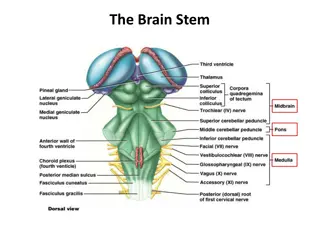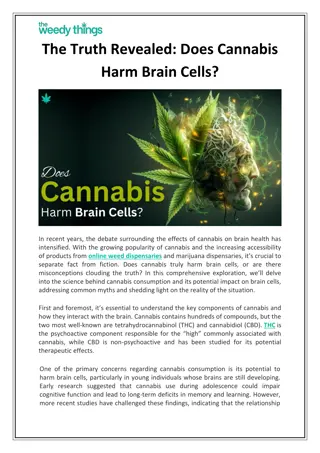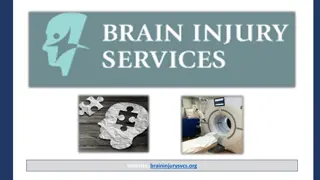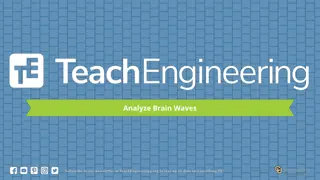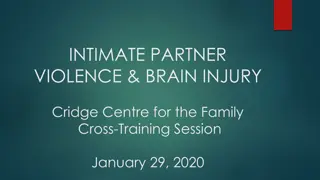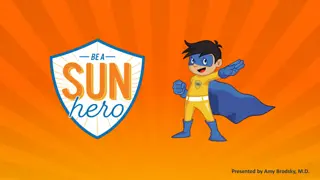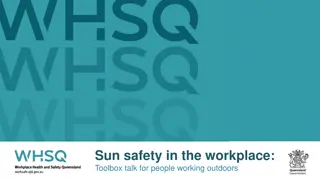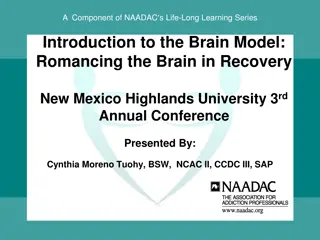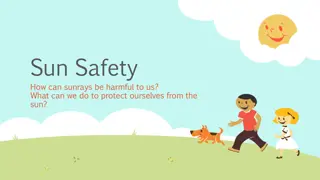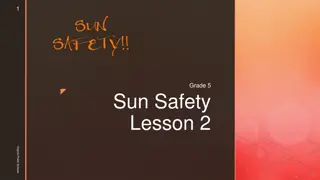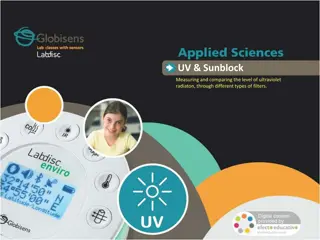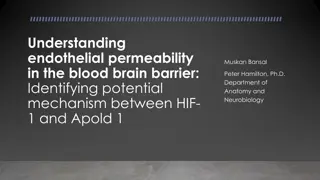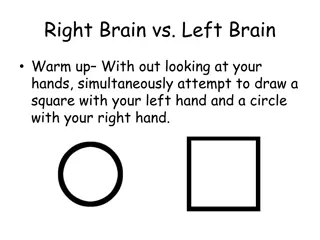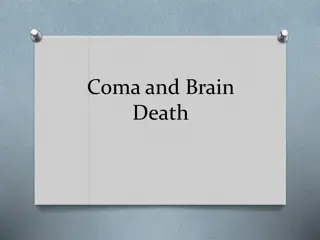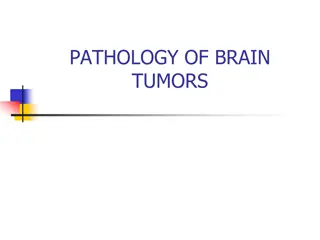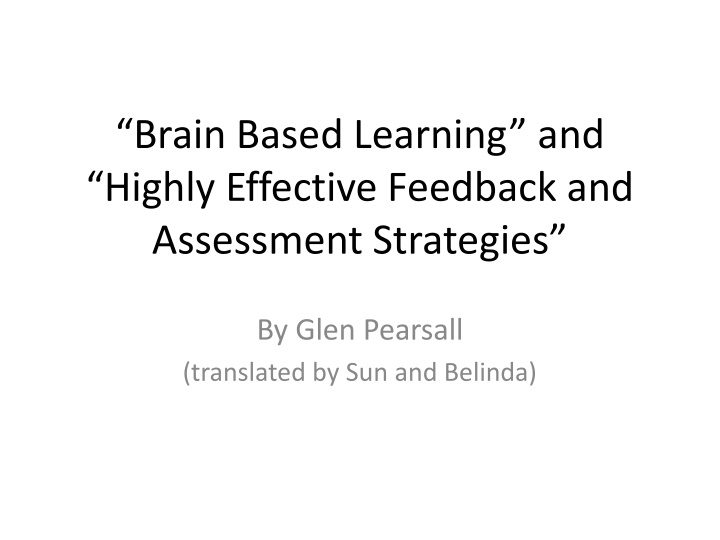
Effective Brain-Based Learning and Feedback Strategies by Glen Pearsall
Explore the three parts of the brain and how to engage students effectively through emotional connections. Discover the role of the teacher in facilitating learning experiences and incorporating reflective practices. Enhance questioning techniques and utilize surveys to gain insights for improving the learning experience.
Download Presentation

Please find below an Image/Link to download the presentation.
The content on the website is provided AS IS for your information and personal use only. It may not be sold, licensed, or shared on other websites without obtaining consent from the author. If you encounter any issues during the download, it is possible that the publisher has removed the file from their server.
You are allowed to download the files provided on this website for personal or commercial use, subject to the condition that they are used lawfully. All files are the property of their respective owners.
The content on the website is provided AS IS for your information and personal use only. It may not be sold, licensed, or shared on other websites without obtaining consent from the author.
E N D
Presentation Transcript
Brain Based Learning and Highly Effective Feedback and Assessment Strategies By Glen Pearsall (translated by Sun and Belinda)
Three parts of the brain The Neocortex is logical, sophiscicated, thinking and reasoning. The Limbic System deals with memory and emotion. The Reptilian Complex is the instinctive part of the brain where fight or flight decisions are made. To learn we need to move students from thinking in the Neocortex to the Limbic System because it helps students to learn when they have a strong emotional connection.
So How do we move students thinking from one part of the brain to another ?
The role of the teacher To be a facilitator who creates opportunities, learning experiences and activities that will evoke an emotional response. Give students with time to think and time to reflect upon their answer or to link and to think . On average Teachers wait 3-5 seconds for a response. 7 students answer 90% of the questions.
Questioning We need to ask good questions that provoke higher level thinking eg open questions and inverted questions (giving them the answer but asking them if they agree and why, eg rather than asking John, is 7 a prime number ? , ask John, 7 is a prime number, can you tell me why ?
Survey STUDENTS As simple as Reflection Time (discussions). No more complicated than Reflection Sheet 1. What was the most significant lesson of the week ? 2. What lesson did you enjoy ? 3. What do you think we will do next week ?
Survey YOURSELF 1. What do students know ? 2. What do they understand ? 3. Where do they make errors ? 4. Where do they have misconceptions ? 5. When are they not engaged ? Knowing these answers enables us to provide opportunities and activities that improve the learning experience for students.
So What are those opportunities, learning experiences and actvitities ?
Competition Buzz Handy for times tables, prime numbers, etc. 9 letter Word Like from the newspaper but a word from the topic being covered W T F A A E L L R
Cheat sheets Ask students to write on an A4 sheet all the notes they think they would need in preparation for an assessment task. All sheets are then displayed and students can walk around the room, reading each others sheets. They then make a choice about which cheat sheet they think is the best and put a sticky note onto it. By making a choice it is tapping into the emotional part of their brain. Glen then photocopies the top 4 student choices (onto 1 A4 sheet back to back) so all students have great notes to study from. Interestingly, they have already done the hard work as they have created their own sheet.
Line debate Provide students with a topic (for example, Democracy is the best form of government). One side is affirmative, the other is negative. Students all need to come up with an argument for their side of the debate. They speak in turns, and if their argument is acceptable to you, they get to choose a team member from the other team to join their side. Students make an emotional attachment to their side, and then have to change sides, and rethink things.
Wordle Provide students with a Wordle taken from an article about a new topic you are introducing. Ask students to work in small groups to determine what the new unit is about, and then ask them to justify their decisions. Great for helping the less inclined student to tune in. You can give them the article on the back, and then move to discussing it. Students can make a Wordle of their oral presentations, and distribute it (helps tune some students in)
Up and Down Ask students true/false or yes/no questions, and ask them to show their response with thumbs up or down or by standing up and sitting down. For example, when discussing nouns, give them examples. Then challenge them with words like sit, which could be a noun or a verb. Ask students to explain their responses. To make lots of these, ask students to take a piece of paper and write one truth and one falsehood about a topic. Read them to the group in turn, and see if they can differentiate. (note: the teacher must read them do not ask a student, as sometimes what is written not accurate).
Exacto Ask students to record a 13 or 21 word summary of what they have learned. This makes them choose their words and refine their ideas. Students can also write lists of concepts from what they have learned, for example, a list of inventions. It is great to then ask them to cut their ideas into strips of paper and organise them in order of importance ie the most to least important inventions, or into time order.
Mini booklets Take two A4 pieces of paper and fold them in half, stapling in a spine. Illustrate a book with what students see as the key things students need to know from the unit. Great for choices and for clarification of ideas. Great for the most important quotes from a book, or lines from a poem or scenes from a play. Remember that each page should be illustrated.
Cold calling Do not be afraid to cold call students. They should get used to being wrong. If a students does not know an answer, ask two students who do know, then ask the original students to choose which answer they think was best. Choices again !! OR ask the original student to rephrase the answer OR ask them to provide an example. Do not allow glossing when students give half an answer and teachers dress it up or accept it.
Race to the Bell To fill small time spaces before the bell (6-7 minutes first time, but it gets quicker) Students ask a question to the class on a given topic. For example Colonial Australia (they must know the answer too). If the question is answered correctly, both students sit down. The goal is to have the whole class sitting before the bell goes.
Proofing Guarantee Sheet Students assess their own work on a set of criteria. Glen Pearsall uses Shown all my working out Put the answer in its simplest form Answered all questions asked Checked calculations for simple errors Presented work clearly At the end, he has a section where students sign I have read my work and hereby testify that it meets the above criteria It can then be checked by another student and co-signed.
I used to think Have students complete sentence strips with the teemplate being I used to think _____________ but now I know_______________
Fist to Five An assessment of approximated confidence with a given topic by raising their fingers (or fist). 0 = I have not mastered it at all 1 = I can sort of do it but need practice 2 = I can sort of do it 3 = I can do it in familiar situations 4 = I can do it in any situation 5 = I could show others how to do it Teachers (or students) can outline what each finger means. Students are signalling the extent of their learning. Other variations are Traffic Lights and Face Expression Cards .
The Worst Response in the World Great for when students just will not do what you are asking them to do (like check spelling). Ask students to do the worst job possible. This makes them evaluate what the best thing is (so they can do the opposite). The difference between playing naughts and crosses to WIN, and playing it to LOSE. Creates a shift from reactive response to mindful response.
KW(H) L Chart What I Know What I Want to know How will I find it out ? What I have Learned
So What do they know ?
We should assess Every lesson not at the end of each unit or term. Assessment must be Fast, Formative and Frequent. But how can we do that ? Many of the activities already mentioned are great for assessment but we also need to be mindful of
Ambush Criteria We should make sure students know our learning intention and criteria for success BEFORE the lesson. Give example to draw a Is it fair ? How do we get around this ?
Step Ladder Rubric Provide students with a partly filled in rubric and ask them to define the blanks. This requires them to actually read and comprehend the criteria. It helps avoid the student who leaves out an entire section. For example High Medium Low Not submitted
Rewrite criteria Students rewrite given criteria as questions For example, Correct spelling becomes Did I use correct spelling ?
And What about their misconceptions ?
How can we tell where the gaps are ? One of the most challenging things is getting students to indicate their misconceptions. We can t ask What are your misconceptions ? because if they knew what they were, they wouldn t be misconceptions. There are three feedback strategies that help students recognise and address their misconceptions. 1. Show them exemplary work = seeing excellence. 2. Have an interim submission date (this is where you assess Hattie and Timperley s Four Levels of Feedback A to C. At the end assess D. 3. Ask them to define what an excellent answer should have.
Other ways to work out misconceptions Sequence Strips (already covered) Speed Sequence Game (give students three minutes to rewrite the steps of a process for an audience of peers (students from a year level below are great). Students can then compare their lists of steps with the person next to them and give a further one minute to revise their list before submitting. Exact Summary (similar to Exacto but where students have to summarise the key learning/idea from a topic that has been studied in a certain number of words (21 works best).
Great references Thinking Fast and Slow by Charles Kahneman Classroom Dynamics Inside the Black Box by Dylan Williams and Paul Black Dr Judy Willis webinar Working Memory The Power of Feedback Hattie and Timperlay Classroom Dynamics on tln.org.au


